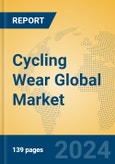Introduction
Cycling wear, including apparel and accessories, enhances rider comfort and performance. The market is driven by growing cycling participation, with 1 billion cyclists globally (2023 UCI report), and rising health awareness. Innovations in breathable, sustainable fabrics and smart wear with sensors fuel growth. The female segment (40% of cyclists) drives demand for stylish designs. The global cycling wear market is projected to reach USD 3.8-7.0 billion in 2025, with a CAGR of 6%-10% through 2030.Regional Analysis
- North America: The U.S. leads with recreational and competitive cycling, while Canada focuses on weather-resistant wear.
- Europe: The Netherlands, Germany, and France drive demand due to strong cycling culture and infrastructure.
- Asia Pacific: China and India grow with rising fitness trends, while Japan emphasizes premium wear.
- Rest of the World: Australia and Brazil expand through adventure cycling trends.
Type Analysis
- Cycle Wear Apparel: Expected growth of 6.2%-10.2%, driven by demand for jerseys and shorts. Trends focus on sustainable fabrics.
- Cycle Wear Accessories: Projected growth of 6.0%-10.0%, including gloves and helmets, with smart features gaining traction.
Distribution Channel Analysis
- Hypermarket and Supermarket: Expected growth of 6.0%-9.8%, targeting casual cyclists.
- Sports Variety Stores: Projected growth of 6.2%-10.2%, with specialized retail driving sales.
- E-commerce: Growth of 6.5%-10.5%, fueled by online convenience and brand websites.
- Others: Growth of 5.8%-9.8%, including direct sales at cycling events.
Key Market Players
Leading firms include Rapha Racing Limited, offering premium apparel; Adidas AG, blending style and performance; Lumiere & Co., targeting sustainability; Nike, focusing on mass appeal; GIRO SPORT DESIGN, specializing in accessories; Manifattura Valcismon, Champion System, Decathlon, Endura Limited, ASSOS of Switzerland GmbH, Isadoreapparel, 2XU, and Pearl iZUMi, innovating in smart and eco-friendly wear.Porter’s Five Forces Analysis
Threat of New Entrants: Moderate, due to brand loyalty, though sustainable startups can enter.Threat of Substitutes: Low, as cycling wear is specialized for performance.
Bargaining Power of Buyers: Moderate, with cyclists seeking quality and affordability.
Bargaining Power of Suppliers: Low, due to multiple fabric suppliers.
- Competitive Rivalry: High, with competition on sustainability, smart features, and style.
Market Opportunities and Challenges
Opportunities:
Growing cycling participation (1 billion cyclists) and female cyclist segment (40%) drive demand.Sustainable and smart wear appeals to eco-conscious consumers, while Asia’s fitness boom boosts sales.
Challenges:
High costs of premium wear limit adoption.Counterfeit products and supply chain disruptions pose risks.
This product will be delivered within 1-3 business days.
Table of Contents
Companies Mentioned
- Rapha Racing Limited
- Adidas AG
- Lumiere & Co.
- Nike
- GIRO SPORT DESIGN
- Manifattura Valcismon.
- Champion System
- Decathlon
- Endura Limited
- ASSOS of Switzerland GmbH
- Isadoreapparel
- 2XU
- Pearl iZUMi








